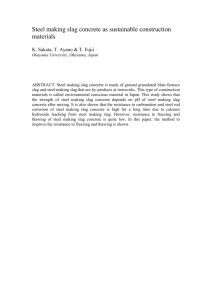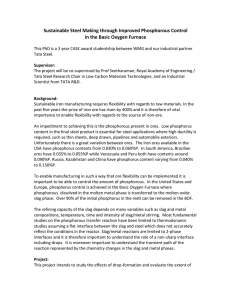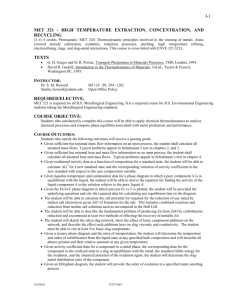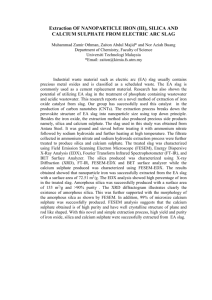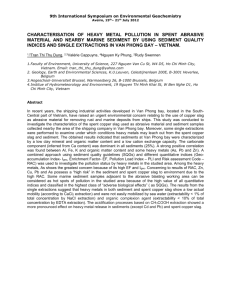Research Journal of Environmental and Earth Sciences 4(2): 142-146, 2012
advertisement
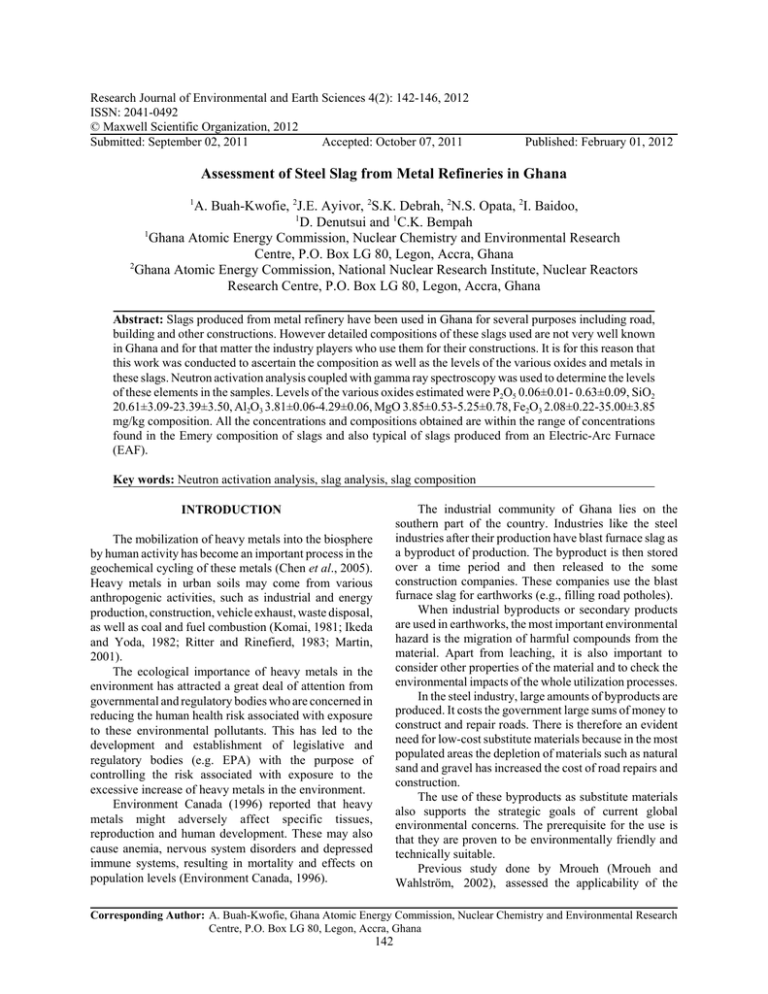
Research Journal of Environmental and Earth Sciences 4(2): 142-146, 2012 ISSN: 2041-0492 © Maxwell Scientific Organization, 2012 Submitted: September 02, 2011 Accepted: October 07, 2011 Published: February 01, 2012 Assessment of Steel Slag from Metal Refineries in Ghana 1 A. Buah-Kwofie, 2J.E. Ayivor, 2S.K. Debrah, 2N.S. Opata, 2I. Baidoo, 1 D. Denutsui and 1C.K. Bempah 1 Ghana Atomic Energy Commission, Nuclear Chemistry and Environmental Research Centre, P.O. Box LG 80, Legon, Accra, Ghana 2 Ghana Atomic Energy Commission, National Nuclear Research Institute, Nuclear Reactors Research Centre, P.O. Box LG 80, Legon, Accra, Ghana Abstract: Slags produced from metal refinery have been used in Ghana for several purposes including road, building and other constructions. However detailed compositions of these slags used are not very well known in Ghana and for that matter the industry players who use them for their constructions. It is for this reason that this work was conducted to ascertain the composition as well as the levels of the various oxides and metals in these slags. Neutron activation analysis coupled with gamma ray spectroscopy was used to determine the levels of these elements in the samples. Levels of the various oxides estimated were P2O5 0.06±0.01- 0.63±0.09, SiO2 20.61±3.09-23.39±3.50, Al2O3 3.81±0.06-4.29±0.06, MgO 3.85±0.53-5.25±0.78, Fe2O3 2.08±0.22-35.00±3.85 mg/kg composition. All the concentrations and compositions obtained are within the range of concentrations found in the Emery composition of slags and also typical of slags produced from an Electric-Arc Furnace (EAF). Key words: Neutron activation analysis, slag analysis, slag composition The industrial community of Ghana lies on the southern part of the country. Industries like the steel industries after their production have blast furnace slag as a byproduct of production. The byproduct is then stored over a time period and then released to the some construction companies. These companies use the blast furnace slag for earthworks (e.g., filling road potholes). When industrial byproducts or secondary products are used in earthworks, the most important environmental hazard is the migration of harmful compounds from the material. Apart from leaching, it is also important to consider other properties of the material and to check the environmental impacts of the whole utilization processes. In the steel industry, large amounts of byproducts are produced. It costs the government large sums of money to construct and repair roads. There is therefore an evident need for low-cost substitute materials because in the most populated areas the depletion of materials such as natural sand and gravel has increased the cost of road repairs and construction. The use of these byproducts as substitute materials also supports the strategic goals of current global environmental concerns. The prerequisite for the use is that they are proven to be environmentally friendly and technically suitable. Previous study done by Mroueh (Mroueh and Wahlström, 2002), assessed the applicability of the INTRODUCTION The mobilization of heavy metals into the biosphere by human activity has become an important process in the geochemical cycling of these metals (Chen et al., 2005). Heavy metals in urban soils may come from various anthropogenic activities, such as industrial and energy production, construction, vehicle exhaust, waste disposal, as well as coal and fuel combustion (Komai, 1981; Ikeda and Yoda, 1982; Ritter and Rinefierd, 1983; Martin, 2001). The ecological importance of heavy metals in the environment has attracted a great deal of attention from governmental and regulatory bodies who are concerned in reducing the human health risk associated with exposure to these environmental pollutants. This has led to the development and establishment of legislative and regulatory bodies (e.g. EPA) with the purpose of controlling the risk associated with exposure to the excessive increase of heavy metals in the environment. Environment Canada (1996) reported that heavy metals might adversely affect specific tissues, reproduction and human development. These may also cause anemia, nervous system disorders and depressed immune systems, resulting in mortality and effects on population levels (Environment Canada, 1996). Corresponding Author: A. Buah-Kwofie, Ghana Atomic Energy Commission, Nuclear Chemistry and Environmental Research Centre, P.O. Box LG 80, Legon, Accra, Ghana 142 Res. J. Environ. Earth Sci., 4(2): 142-146, 2012 Table 1: Sample irradiation scheme used for analysis Irradiation Decay time (sec) time (sec) Short-lived radionuclide 10 120-300 Medium-lived radionuclide 3600 86400 Long-lived radionuclide 7200 1209600 by product of steel industries and recycled materials in earth construction in Finland, where the environmental aspects of the utilization were investigated. The ultimate aim of this study is to investigate the heavy metal and trace element contents and concentration in the slag that is released by the steel companies for earth orks (roads, walkways) in the most populated city in the country and to verify whether the concentration of the heavy metals and trace elements are within acceptable limits using the Slag Utilization in Pavement Construction (Emery, 1982) as the yardstick. Sample preparation for neutron activation analysis: Each pulverized and sieved sample from the four different locations was then split uniformly onto seven glass bottles of equal volumes using riffle splitter (to check for homogeneity by analyzing four bottles separately of the same sample). About 100 mg of each of the samples (including standard reference materials Estuarine sediment and GBW soil 7) were weighed and wrapped into transparent polythene (pretreated with acetone) and then encapsulated into an irradiation capsule (rabbit capsules) for irradiation. Triplicate of each sample of about 100 mg were then taken and encapsulated in the radiation capsule and sealed using an ERSA MS 6000 soldering machine for irradiation. The reference standard materials were treated the same way as the samples for irradiation. MATERIALS AND METHODS A total of about four samples were taken from heaps of steel slag from metal refineries in the Tema (Accra Metropolis) industrial area in the early part of the year of 2010. Materials and apparatus: Mettler scale model PM100, 10 mL measuring cylinder, Soldering Machine (ERSA MS 6000), 12 mL rabbit capsule, Cotton wool, Jaw crasher (serial No. 01.5030107707 by Retsch GmBH), Pulverizer (Instrument No. 02.2000.00 and serial No. 6101 by Fritsch GmBH), Sieve (Type AS 200 control, Serial No. 126201001 by Retsch GmBH), Riffle splitter (Type PT 100, serial No. 127050302D by Retsch GmBH), Fume chamber and Research Reactor (GHARR-1). Sample irradiation and counting: Samples and standards were irradiated in the Ghana Research Reactor (GHARR-1) at the Ghana Atomic Energy Commission, operating at a power of 15 KW at a thermal flux of 5×1011 n.cm-2.s-1 . Samples were transferred into irradiation sites via pneumatic transfer system at a pressure of 60 psi. The irradiation was categorized according to the half-life of element of interest. The Table 1shows the irradiation scheme used for the various element of interest and the scheme is also based on the half life of the element of interest. After the irradiation, radioactivity measurement of induced radionuclide was performed by a PC-based (-ray spectrometry set-up. It consists of an n-type HPGe detector coupled to a computer based Multi-Channel Analyzer (MCA) via electronic modules. The relative efficiency of detector is 25% and its energy resolution of 1.8 keV at (-ray energy of 1332 keV belonging to 60Co. Through appropriate choice of cooling-time, detector’s dead time was controlled to be less than 10%. Identification of (-ray of product radionuclide of interest, through their energies and quantitative analysis of their concentrations were achieved using the (-ray spectrum analysis software, ORTEC MEASTRO-32 and a spreadsheet (Excel) based program developed based on the relative comparator equation described below: Sampling: The waste slag were sampled from four different locations from the factory site, these were: • • • • Counting Time (sec) 600 600 36000 The continuous heap of waste directly from the manufacturing machines. The preceding day’s heap of waste slag. The heap ready to be re-damped on the factory daping side on the factory premises. The heap ready to be re-damped outside the factory premises (those ready to be collected by interested individuals and companies for various purpose). A total of about four samples were taken from each heap with an approximate weight of each sample being about 2 kg. These samples were then placed in a polythene bags which had been pretreated with acetone. They were then transported from the factory location to the Neutron Activation Analysis (NAA) Laboratory at the Ghana Atomic Energy Commission. Field samples from each heap were then placed in a bowl and mixed. Laboratory samples from these samples were then taken and crashed separately using a jaw crasher. Each separate fraction of the crashed samples from the various heaps were then pulverized to very fine powder and sieved to a mesh size of 125 micron. Dsam = ([(PA/tc)CD] sam [DW] std)/ ([(PA/tc)CD] std. Wsam) For quality assurance, GBW6, GBW7, IAEA Soil-7 and IAEA Estuarine Sediments (standard reference materials) were included. 143 Res. J. Environ. Earth Sci., 4(2): 142-146, 2012 Table 2: Analysis of GBW Soil 7 SRM by INAA Element/concentration (mg/kg) This work Ca 159243±100 Al 49219±112 Mg 12100±83 Fe 28200±28 Na 2491±28 Cu 9.8±0.51 La 29.54±3.21 V 65.00±3.20 Reported 163000 47000 11300 25700 2400 11 28 66 Accuracy (%) 2.3 - 4.7 - 7.1 - 9.7 - 3.8 10.9 - 5.5 1.5 Precision (%) 0.06 0.2 0.7 0.1 1.1 5.2 10.9 4.9 Table 3: Analysis of estuarine sediment SRM by INAA Element/concentration (mg/kg) This work Ca 0.48±0.02 Al 1.98±0.02 Mg 0.33±0.001 Fe 1.91±0.01 Na 0.68±0.018 Cu 9.25±0.19 La V 42.84 ± 3.11 Reported 0.519±0.020 2.297±0.018 0.388±0.009 2.008±0.039 0.741±0.017 10.01±0.34 -44.84 ± 0.76 Accuracy (%) 7.5 13.8 14.9 4.9 6.9 7.6 4.5 Precision (%) 4.2 1.0 0.3 0.5 2.6 2.0 7.3 Table 4: Typical steel slag chemical composition after Emery (1982) Constituent Composition CaO 40-52 10-19 SiO2 FeO 10-40 MnO 5-8 MgO 5-10 Al2O3 1-3 P2O5 0.5-1 S #0.1 Metallic Fe 0.5-10 the slag not meeting the required standards, hence the physical characteristics of the slags when used for construction purposes will be affected and can result in short life span of projects due to wear. This therefore means that further chemical processes has to be done on the slags from the various sites before they can be used for the purposes for which they are being used currently which include road construction, building construction and other types construction purposes. However the ranges of FeO, CaO, SiO2, Al2O3, MgO were comparable to the ranges of oxides composition of slags produced by Electric-Arc furnace (EAF) (rem and Monica, 2009), slag 4, slag 1 and slag 3 had FeO and CaO lower than the ranges proposed in slag produced by EAF. There is therefore the need for further chemical amendment to be done on some of these slags before they are used for their respective purposes to enhance their life span. It has also been established that very little impacts if any is left in the environment particularly in aquatic systems as a result of these slags (National Slag Association, 2003). The result of the elemental analysis of the samples collected is shown in Table 6. Generally the levels of all the metals found in all the four slag samples were within the recommended levels in soils, it is important to emphasize that, the oxidation state of some of them are of very great importance. This is because an element like chromium in it hexavalent state can cause a number of health problems such as kidney and liver damage, skin rashes etc, and these have been particularly identified in people who work in the steel and metal industries (Lenntech, 1998). There is therefore the need to reduce exposure of workers to high levels of such elements in the working environment by adopting best available techniques and best environmental practices. Levels of metallic iron identified in almost all the slags were all within the concentration range of the Emery slag composition in Table 4 with the exception of slag The quantitative analysis of the concentrations was done using relative comparator method. RESULTS AND DISCUSSION Validation of the method was carried out using GBW soil 7 (Certificate of Analysis IAEA) and estuarine sediment (Certificate of Analysis, 2004) standard reference materials supplied by the International Atomic Energy Agency. Table 2 and 3 shows the accuracy and precision (measured as the relative standard deviation after five (5) measurements) associated with the data obtained from this method. Table 4 shows a typical Emery (1982) composition of constituent a slag must contain before they can be used for various purposes such construction aggregate material in project such as building, road construction etc. Table 5 shows the compositions of the oxides of the various elements from different samples taken from the sampling sites and also data obtained from a similar work done in Nippon, Japan (Nishiharan et al., 2002). With the exception of SiO2 and Al2O3 which had concentrations greater than the Emery values, the rest of the elements and compounds had their concentration levels lower than the recommended values from Emery steel slag chemical composition. Concentration values below the values given in Emery steel slag composition result in the properties of 144 Res. J. Environ. Earth Sci., 4(2): 142-146, 2012 Table 5: Concentrations of various parameters measured from the four slag samples concentration in mg/kg Sample ID Slag 1 Slag 2 Slag 3 21.84±3.28a 21.78±3.26a 23.39±3.50a SiO2 MgO* 4.85±0.73 4.44±0.67 5.25±0.78 Al2O3* 4.29±0.06a 4.15±0.06a 3.88±0.06a CaO* 5.92±0.37 23.04±0.74 6.00±0.53 Fe2O3* 35.00±3.85 26.14±2.88 26.99±2.97 TiO2* 0.87±0.10 0.79±0.09 1.00±0.12 MnO2 * 1.51±0.02 3.76±0.02 1.83±0.02 Na2O* 0.50±0.05 0.53±0.09 0.35±0.06 P2O5 0.45±0.07 0.36±0.06 0.63±0.09 *: Concentrations in %; a: Samples with concentrations higher than Emery typical steel slag composition Table 6: Concentration in mg/kg Sample ID Slag 1 Th 0.39±0.06 Ni 0.26±0.04 Co 3.07±0.46 Zn 12.77±1.66 Cu 26.58±0.99 V 16.22±1.78 As 0.02±0.003 Cd <0.01 Cr 66.08±7.93 S 0.27±0.03 Hg 0.07±0.01 Cs 0.13±0.02 U 0.30±0.05 La 110.13±12.11 Metallic Fe 5.25±0.78 Slag 2 0.21±0.03 0.19±0.03 2.59±0.38 11.60±1.39 20.37±3.06 19.98±2.99 0.07±0.01 0.09±0.01 53.93±8.09 0.29±0.03 0.04±0.01 0.05±0.01 0.21±0.03 201.23±22.13 3.92±0.58 number4 which had concentration of 0.31 mg/kg which was lower than the recommended range of between 0.5-10 mg/kg as seen from the ery figures in Table 4. Slag 3 0.32±0.05 0.26±0.04 2.52±0.37 2.29±0.27 21.05±3.15 14.92±2.24 0.05±0.01 <0.01 62.42±6.86 0.26±0.03 0.07±0.01 0.03±0.01 0.15±0.02 142.13±15.63 4.04±0.06 Slag 4 20.61±3.09a 3.85±0.53 3.81±0.06a 27.92±0.91 2.08±0.22 0.69±0.10 4.94±0.03 0.24±0.03 0.06±0.01 Nippon steel 37.44±3.17a 1.73±0.18 17.07±1.59a 36.81±2.94 0.53±0.29 3.49±0.81 - Slag 4 0.14±0.02 0.07±0.01 1.68±0.25 1.40±0.17 22.32±3.35 15.83±2.37 0.02±0.003 <0.01 19.30±1.12 0.42±0.04 0.09±0.02 0.23±0.03 0.35±0.05 98.78±10.87 0.31±0.05 Nippon steel 0.20±0.05 2.79±0.55 0.43±0.08 0.28±0.04 86.49±3.15 Environment Canada, 1996. The State of Canada’s Environment. Public Works and Government Services Canada, Ottawa. Ikeda, A. and K. Yoda, 1982. Soil pollution by heavy metals in Sakai City. Japanese J. Ecol., 32: 241-249. Irem, Z.Y. and P. Monica, 2009. Use of Steel Slag in Subgrade Applications, Publication FHWA/IN/JTRP2009/32. Joint Transportation Research Program, Indiana Deparatment of Transportaion and Purdue University, West Lafyette, Indiana. Doi: 10.5703/1288284314275. Komai, Y., 1981. Heavy metal contamination in urban soils: I. Zinc accumulation phenomenon in urban environments as clues of study. Bull. Univ. Osaka Pref., 33: 7-15. Lenntech, 1998. Water Treatment Solutions Website, Chemical Properties, Health Effect and Environmental effects of Chromium. Retrieved from: http://www.lenntech.com/periodic/elements/cr.htm. (Accessed June, 2011). Martin, L., 2001. Urban land use influences on heavy metal fluxes and surface sediment concentrations of small lakes. Water Air Soil Pol., 126: 363-383. Mroueh, U.M. and M. Wahlström, 2002. By-product and recycled materials in earth construction in Finlandan assessment of applicability. Res. Cons. Rec., 35: 117-129. National Slag Association-Leachate from blast furnace slag, 2003. CONCLUSION Levels of heavy metals compositions in slags produced from this company are generally low and are within levels that might not be very harmful to workers. The oxides produces are also within the recommended levels given in the Emery composition table and are also comparable to those produced from Electric-Arc Furnace (EAF). The slags produced can therefore be used for the purposes such as construction of road, building etc with very little amendments. REFERENCES Certificate of Analysis,2004. Certified Reference Material Soil 7, International AtomiAgency, Vienna. Chen, T.B., Y.M. Zheng, M. Lei, Z.C. Huang, H.T. Wu, H. Chen, K.K. Fan, K. Yu, X. Wu and Z.Q. Tian, 2005. Assessment of heavy metal pollution in surface soils of urban parks in Beijing. China Chemosphere, 60: 542-551. Emery, J.J., 1982. Slag Utilization in Pavement Construction,” Extending Aggregate Resources. ASTM Special Technical Publication 774, American Society for Testing and Materials, Washington, DC. 145 Res. J. Environ. Earth Sci., 4(2): 142-146, 2012 Nishiharan, N., Y. Iyoku, S. Osada and M. Osada, 2002. Technology of using molten slag and metal generated from municipal solid wastes: Nippon Steel technical report No 86. Ritter, C.J. and S.M. Rinefierd, 1983. Natural background and pollution levels of some heavy metals in soils from the area of Dayton. O.H. Environ. Geol., 5: 73-78. 146
